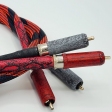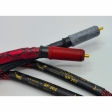Measuring Feelings
Measuring Feelings in Music
Once in a great while, I get asked about this measurement or that rating. Even rarer is the person who will almost throw a tantrum and demand this or that. - Well, I truly don't understand that mentality. As if that extra 0.1 on the Richter scale is going to make a difference whether you live in Long Beach or Newport Beach.
Measuring feelings
The argument that music playback should be judged solely by measurements such as frequency response, total harmonic distortion (THD), or signal-to-noise ratio (SNR) misses the fundamental essence of music and art as human experiences. While scientific measurements provide useful benchmarks, the artistic and emotional experience of music transcends quantifiable metrics.
1. Music is About Emotional Connection
- Music is a form of emotional communication. The notes, dynamics, and timbre of a song evoke feelings like joy, sadness, nostalgia, or excitement.
- The experience of listening depends on how those emotions are conveyed to the listener. No measurement can capture whether a piece of equipment helps the listener feel more engaged or emotionally moved.
- For example, warmth and richness in sound can’t always be quantified but can greatly influence the listener's connection to the music.
2. Art is Subjective, Not Objective
- Just as people have different tastes in paintings or literature, they have different preferences in how they experience music playback.
- Some listeners prefer the smooth, organic sound of vinyl records, while others appreciate the pristine clarity of digital formats. Neither preference is "wrong" because the value lies in subjective enjoyment, not numerical superiority.
- Scientific measurements might declare one format “better” than another, but if a format or piece of equipment provides a more emotionally satisfying experience, that is what matters.
3. The Human Ear is Not a Machine
- Human perception of sound is influenced by psychological and emotional factors, which aren’t captured by measurements.
- The brain processes sound based on factors like context, memory, and mood. Two people listening to the same equipment might experience it very differently.
- Measurements like THD might indicate tiny imperfections in sound, but many listeners find these imperfections add character and life to the music (e.g., the pleasing distortion of a tube amplifier).
4. Performance vs. Experience
- Measurements focus on the performance of the equipment, while the listener’s concern is the experience of the music.
- Consider how a live performance in an intimate venue may technically have more imperfections than a studio recording, yet the raw energy and connection make it unforgettable. The same applies to audio playback: it’s about how the music feels, not just how the equipment performs.
5. Measurements Miss Nuance and Complexity
- Audio measurements can only capture specific aspects of sound (e.g., frequency range, noise floor). They miss more nuanced factors like:
- Soundstage and imaging: The sense of space and placement of instruments.
- Tone and timbre: The quality of an instrument's sound.
- Microdynamics: Subtle shifts in volume and expression.
- These nuances greatly influence the artistic experience but are difficult to fully quantify.
6. Historical Examples in Art
- Many revered artists and musicians used tools or methods that were “imperfect” by modern standards.
- The use of analog synthesizers, vintage recording equipment, or classic guitar amps adds a character that cannot be replicated by technically superior digital gear.
- In visual art, the texture of a brushstroke or the grain of a film photograph is valued for its aesthetic quality, not its technical precision.
7. The Intangible Quality of Beauty
- As with any art, there is an intangible beauty in music that defies measurement.
- The "magic" of listening to a piece of music often comes from a combination of subtle imperfections, unique tonal qualities, and emotional context—all of which can’t be captured in charts or graphs.
To Sum it Up...
While measurements are valuable tools for understanding the capabilities of audio equipment, they do not define the artistic experience of music. Music is about the emotions, memories, and feelings it evokes. True appreciation comes from the art of listening, not from the sterile pursuit of measurements and technical perfection.
Ultimately, the best equipment is the one that makes you feel most connected to the music—not necessarily the one with the most impressive specs.
Jonny Wilson







